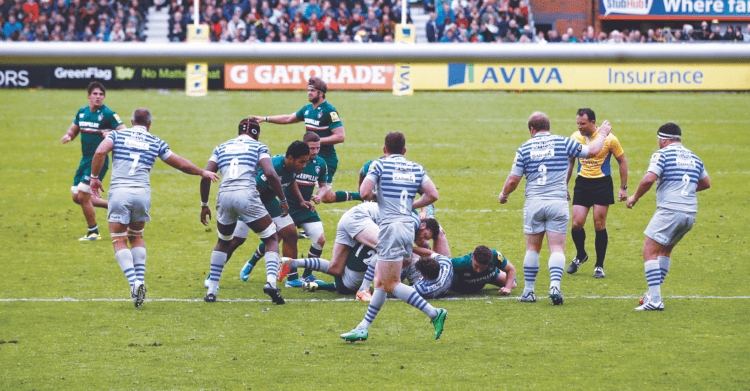Plug the gaps at the ruck
Defenceby Nigel Botherway

All in place: Saracens have two guards evenly spaced on either side of this ruck, with the 9 in the “boot” ready to organise. The inside guard looks in whilst the outside guard (7) looks at possible threats
Get your defensive structure right at the breakdown to ensure you don’t give away easy metres. Your players need to know their responsibilities to stop opponents “going through the guts”.
With attacking 9s constantly sniping, or forwards using the pick-and-go or attacking “round the corner” off the scrum half, it’s vital that your defence is solid around the breakdown.
The most effective way to shut out the opposition around the ruck or tackle area is by employing guards, preferably forwards.
The first thing your guards need to calculate, however, is whether the breakdown is winnable. Talk through and practise different scenarios in training so that your players can make split-second decisions in the heat of battle about whether to compete for the ball by counter-rucking, or to concede possession and guard the fringes.
FIRE AND ICE
Organised teams have calls at the ruck, such as “fire” and “ice”.
“Fire” translates as: “Yes, we have a chance of winning this, so let’s pour through the gate and counter-ruck.”
“Ice” equates to: “We stand more risk of conceding a penalty or getting creamed than gaining a turnover. So let them commit numbers to the breakdown, while we fan out either side and use our numerical advantage to win the ball at the next breakdown, drive them backwards or force them into a mistake.”
KNOWING THEIR ROLES
The best defensive policy is for one player to guard the blind side and three to guard the open. Or stand two guards either side if the ruck is centre-field.
Teach your players that the first guard tackles the pick-and-go player, but not the scrum half, or a runner, coming round the corner. Let the second guard tackle him, so that the first guard can cover the threat of an inside pass.
The furthest guard should be free to put pressure on the fly half when the ball is released. The defensive 9 should act as a sweeper and organise his guards.
Some coaches assign each guard a title, such as “guard” and “guard dog”, or they number them from one to four, so that they can number off as they arrive in their practised defensive formation.
What you call these defensive guards doesn’t matter, but ignore this facet of the game at your team’s peril.
A WARM-UP DRILL
Here’s a warm-up drill you can use to start the session.
- Have your players run around in a 10m square box.
- “Name” its four sides.
- You stand in the middle, with your foot on a ball.
- When you shout out the “name” of one of the sides, your players run to this side of the box and take up a three-point stance (see panel) facing into the box.
- When you then touch the ball with your hand, the players must move forward 3m, keeping low, before returning to jogging around the box.
AND THEN...
HOW TO BE A GOOD GUARD DOG
- Set yourself low in a “three-point stance” – both feet set, one hand down on the ground, eyes looking up – one step outside the edge of the ruck.
- Once the ball carrier breaks from the ruck, drive into them under their chest, then keep driving them back.
Newsletter Sign Up
Coaches Testimonials

Gerald Kearney, Downtown Las Vegas Soccer Club

Paul Butler, Florida, USA

Rick Shields, Springboro, USA

Tony Green, Pierrefonds Titans, Quebec, Canada
Subscribe Today
Be a more effective, more successful rugby coach
In a recent survey 89% of subscribers said Rugby Coach Weekly makes them more confident, 91% said Rugby Coach Weekly makes them a more effective coach and 93% said Rugby Coach Weekly makes them more inspired.
Get Weekly Inspiration
All the latest techniques and approaches
Rugby Coach Weekly offers proven and easy to use rugby drills, coaching sessions, practice plans, small-sided games, warm-ups, training tips and advice.
We've been at the cutting edge of rugby coaching since we launched in 2005, creating resources for the grassroots youth coach, following best practice from around the world and insights from the professional game.














